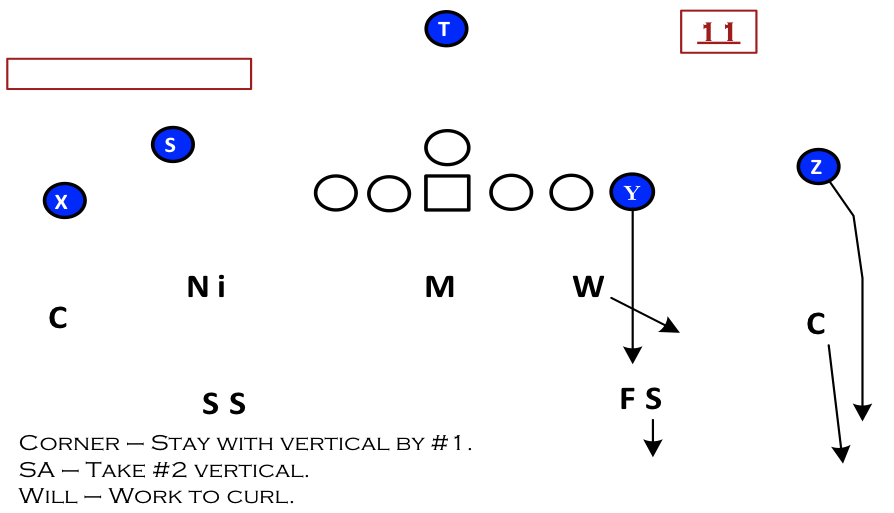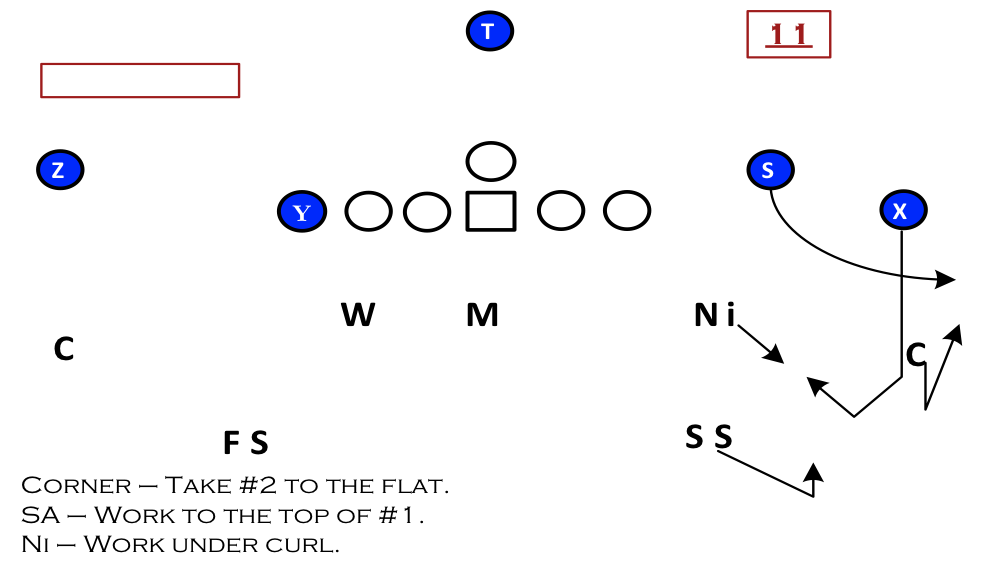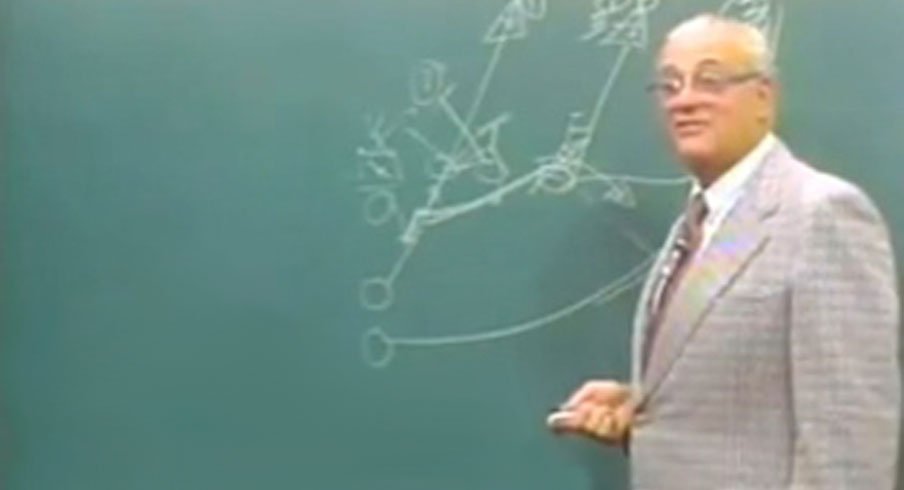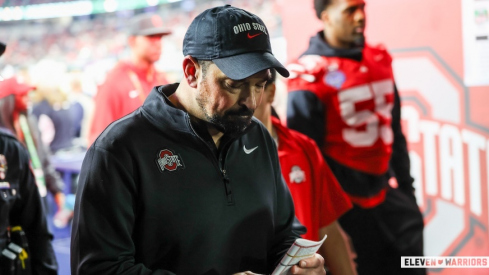It is no secret that Urban Meyer’s Ohio State tenure has been marked by inconsistent defense. Poor defensive play cost Ohio State its undefeated season against Michigan State and then the Orange Bowl versus Clemson.
Much of that inconsistency is attributable to a lack of defensive identity. And that, in turn, stems from Meyer’s staff’s on again, off again relationship with cover 4, aka quarters.
Setting the Table
Defensive schemes start with determining the coverage. The called coverage determines what type of front the defensive will play, how many rushers the defense will have against the pass, and what defenders will have force, spill and lever support. More intrinsically, its sets the tone for the entire defense. How aggressively a defense plays is generally determined by its base coverage scheme.
The Buckeye defense in 2012 and 2013 struggled in all these areas because they have lacked a consistent coverage framework. This has largely resulted from the defensive coaching staff’s failed attempt to implement cover 4.
Good in Theory
To take a step back, it is clear that Meyer has wanted his defense to play cover 4 since he took the Ohio State head coaching position. That should be no surprise. Cover 4 has grown in popularity to counter the rise of the spread offense.
Though it sounds like a prevent defense, cover 4 is actually an aggressive matchup zone. The critical aspect is the safeties. They put their heels at 10 yards and read the number 2 (inside) receiver to their side.

If the receiver blocks, the safeties flow downhill against the run. If No. 2 releases vertically, the safety plays that receiver in man coverage, with the corners playing man against the outside receiver.

If the No. 2 releases outside, the safety passes him off to the corner, knowing that the outside receiver is crossing into his zone, whom he will pick up in man coverage.

This versatility provides quarters’ effectiveness against spread to run offenses. The defense has the ability to cover 4 vertical routes, while also applying two additional defenders against the run to account for the quarterback run threat. In other words, a coverage that accounts for 4 spread receivers also becomes a nine-man front against the run.

It should thus be no surprise that Meyer would want to adopt the defense that has been most effective against his spread offense. Meyer simply had to look across the field in the Big Ten Championship game to Pat Narduzzi’s Michigan State cover-4 defense to see the aggressiveness the scheme allows against spread to run offenses and know that is what he would like his defense to emulate.
With a Short Circuit in Implementation
As such, when Meyer put together his staff in the fall of 2012 he brought in Everett Withers as co-defensive coordinator and safeties coach to team with Luke Fickell. Withers’ background was in cover 4 and his intent was to bring the concept to the Ohio State defense. This was a change from the Jim Heacock era, where the Buckeyes’ effective defenses based from cover 3.
The Ohio State defense spent spring and fall practice in 2012 repping cover 4, and opened the 2012 season utilizing the concept. But the Buckeye coaching staff’s cover 4 plans quickly clashed with reality, as the Buckeye defense struggled mightily utilizing the concept in first half of the season.
Ohio State’s application of cover 4 had several shortcomings. Cover 4 changed the Buckeyes’ force support against the run from the outside linebacker or nickel to the safeties. The Buckeye defense struggled with this change, as the safeties failed to consistently provide force support. Against the pass, the Buckeye safeties and linebackers too often had breakdowns with the man coverage often required with cover 4.
Ohio State staunched the bleeding in 2012 by going with a hybrid. Against pro-style teams the Buckeyes returned to a cover 3 based defense. Against spread teams, the Buckeyes largely stayed with cover 4 but altered force responsibility, shifting it back to the nickel position and having the safety fill the alley.
Another Step Back
It was assumed that the Ohio State defensive coaching staff would use the 2013 offseason to iron out the kinks with cover 4. Instead, the 2013 Buckeyes largely eschewed the coverage entirely, opting to return to cover 3.
The problem was that the cover 3 utilized by the Buckeye coaching staff in 2013 was a vanilla version that was consistently vulnerable in the underneath flats. Nowhere was that more emblematic then against Clemson, as the Tigers threw dozens of wide receiver screens that resulted in sizable yards after the catch. The Buckeye defensive coaching staff seemed unable or unwilling to alter its coverage framework to limit these easy completions. Yet despite taking a conservative approach, the Buckeye defense too often had coverage breakdowns that resulted in explosive plays.
A New Era
Following the season, the Buckeye coaching staff underwent a shake-up. Withers left for James Madison. In his place Meyer brought in Chris Ash. With explicit instructions to fix the pass defense, Ash’s focus is to simplify and streamline the Buckeye defense.
But Meyer’s hire reflects a related goal – to resurrect the cover 4 match-up zone he wanted to bring to Ohio State in 2012. Ash is known for utilizing quarters, and the 2014 Buckeyes will base from the coverage often, particularly against spread offenses. Ash’s marching orders are to implement his aggressive, pattern-matching coverage in a sound manner and avoid the missteps that prevented the Buckeyes from successfully utilizing cover 4 the previous two seasons.
As such, whether the Buckeye defense improves in 2014 largely depends on whether Ash succeeds in getting the Buckeye defense to effectively play cover 4. In part II I will look at some specifics of Ash’s cover 4 defense, focusing upon how he can avoid the potholes that derailed the Ohio State defense in 2012 and 2013.


